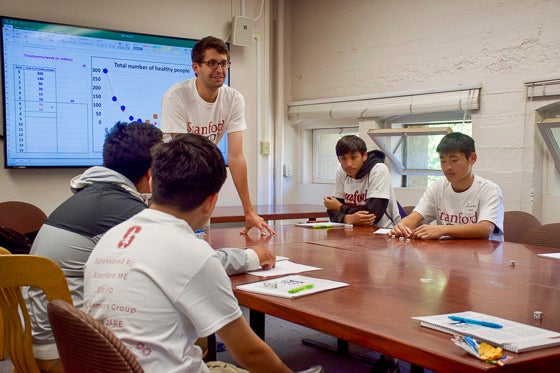On a sunny Saturday, 51 students from Bay Area middle schools and high schools traveled to Stanford’s Mechanical Engineering building for an afternoon of engineering feats such as making an autonomous car work, building bird wings and even (hypothetically) saving the world from disease.
Now in its second year, See Mechanical Engineering (SeeME) is a one-day program that teaches local teens about concepts in engineering through hands-on, interactive classes. It also exposes those kids to diverse role models in engineering fields.

Eighth graders try to mix a stratified fluid without stirring it to simulate how hard it is for the ocean to mix while graduate student Michelle DiBenedetto looks on. (Image credit: Mason del Rosario)
Mechanical engineering graduate students Ohi Dibua and Zach del Rosario were inspired to initiate this student-run outreach and education program by a one-day educational program put on by mechanical engineering Professor Gianluca Iaccarino in 2016. Iaccarino’s program was for a single middle school class, but Dibua and del Rosario decided to take it a step further by inviting several local middle and high schools.
Dibua had initiated a similar program as an undergraduate student at the University of Pittsburgh and was heartened by the positive feedback he received. He wanted to continue sharing his passion for engineering with teens and adolescents. “I enjoy engaging in the community, and I want to keep doing that throughout my career,” said Dibua. Plus, he added, “Kids are more fun than adults.”
Dibua and del Rosario recruited fellow mechanical engineering graduate student Sadaf Sobhani to act as the program director of SeeME this year, after her successful teaching role in the program last year.
Sobhani’s passion for the program stems from her own journey as a female engineer, where relatable role models and meaningful human connections were critical. “We’re a diverse set of teachers, and that motivates us. We all wish we had this when we were in high school,” Sobhani said. She now hopes to make herself visible to young students who might be considering a career in engineering. “I feel I have a responsibility to help inspire interest in STEM learning, especially in groups underrepresented in this field,” she added.
A team of more than 20 engineering graduate students ran the program – from recruiting middle and high school students to creating and teaching the classes. The recruiting process alone required more work than they’d expected. They made repeated visits to over a dozen middle and high schools from Millbrae to San Jose, including several underserved schools in the area, to convince teachers and administrators the value of sending their students. SeeME also provided transportation for students from every school. “We wanted to remove any barriers for these students to participate” Sobhani said.

Under the guidance of graduate student Maxime Bassenne, teens roll dice to predict the weekly spread of an infectious disease as a way to learn about the power of computational mathematics. (Image credit: Mason del Rosario)
Once at Stanford, the teens dove into two of the six classes offered for the day: biomechanics of bird flight, desalination, cardiovascular flows, vehicle dynamics, computational mathematics and ocean mixing. Between classes, the students heard from Stanford mechanical engineering alum Erica Chin, who shared her story of how her love of art inspired her to become an engineer, and how her education in engineering helps her create biomedical products that save lives.
At the end of the day, students said they were surprised to learn that engineering covers such a broad range of topics. “Those classes were fantastic, and I wish I could do more,” one student wrote in a review. “I came here believing that engineering was only about cars, motors and machinery. I discovered that engineering could be used in anything,” wrote another.
The teens aren’t the only ones who learned something. “This was a great experience for the teachers,” said Sobhani. Unlike the teens they’d met that day, some of the teachers reflected on the fact that they had very few, if any, obstacles to becoming an engineering student at Stanford.
“It will help those graduate students in their career because they’ll have to work with people from other backgrounds. And, hopefully, they will choose to interact with people from diverse backgrounds and be good at it,” Dibua said.
The graduate students plan to continue the program and next year hope to recruit more students from middle schools, who are at a critical age for making engineering-focused class decisions. Sobhani said she’s thrilled by the enthusiasm her fellow graduate students have for teaching kids about engineering. “Our goal is to inspire students and get them excited about engineering, and we all have a strong passion for that,” said Sobhani.
SeeME was funded by the Stanford Department of Mechanical Engineering, Stanford Women in Fluid Dynamics, the Mechanical Engineering Women’s Group and the Stanford DARE–Diversifying Academia, Recruiting Excellence Doctoral Fellowship.
Media Contacts
Sadaf Sobhani, Mechanical Engineering: ssobhani@stanford.edu
Ohi Dibua, Mechanical Engineering: odibua@stanford.edu
Amy Adams, Stanford News Service: (650) 497-5908, amyadams@stanford.edu